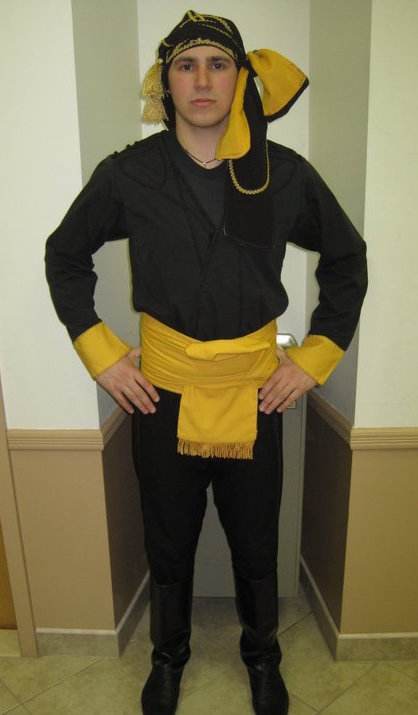
Asia Minor
Asia Minor, also referred to as Anatolia, is the westernmost region of the country of Turkey. Throughout history there was a significant Greek population in this region. Some of the areas highest in Greek population were Cappadocia, Constantinople, Ikonio, Meli, Pontos, and Smyrna.
Popular dances from Asia Minor
Etere (Trabzon), Ez Vasilis (The Farassa) Hasaposervikos, Kotsari (Kars), Houliaria/Horos Ton Koutalion, Leilaloum (Karvali), Mo Ta Glexe/Horos Ton Mantilion, Palio Zeibekiko (Ikonio), Serenitsa (Xeriana), Sourountina (Misti), Syrtaki, Tis Augis, Tsift (Silli), Tsifteteli, Vara Vara (Misti), and Zeibekiko
Costumes from Asia Minor
| The creation of this women’s Pontian costume along with the creation of a general “Pontian dress” is related to the idea of forming an ethnic Pontian identity with the population exchange of 1923. The costume expresses the need for a Pontian identity especially from the third and fourth generation refugees. The current Pontian costume is primarily based on research, testimonials, and the few surviving garments from the refugees, all which aided in the creation of today’s Pontian costume and the disappearance of the regional costumes of Trapezounda, Livera, and Ak Dag. | ||||
| This is the male costume from Pontos. The black long-sleeved cotton shirt featured a row of bullets, which highlighted the tradition of war throughout Pontos. The “zipka” were pants made from black woolen cloth and ended at the knees. The sash was typically fashioned from wool or silk and was made to be 3-4 meters long. The boots that accompany this costume were called “tsapoulas.” |  |
 |
||
| The female costume from the Farasa of Cappadocia is one that was designed by Yiannis Tsarouhis upon request by the renowned folk dance researcher Dora Stratou. The orange and red motifs of the costume represent the dry, rocky soil typical of Cappadocia. In addition the blue seen on the costume is reminiscent of the clear, blue skies seen in the Farasa. The headscarf, which often gets confused as a Muslim garment, was actually worn to protect their hair from dust and sand while working in the fields. |  |
 |
||
| The male costume of Cappadocia is a costume that was widespread throughout the broader area of Cappadocia, unlike the women’s costumes which differed by region. Beyond the differences in textiles because of local handicraft and professional diversities, the male costume of the mid 19th century consisted of undergarments (the “vrastie”), a shirt (the “met imat”), pants (the “kiatipiges”), a vest (the “islits”), a belt (the “kemet”), a jacket (the “salta”), and the hat which the Misiotes supposedly borrowed from Russians. |  |
 |
||
| This female costume is from Silli, Ikonio, which is currently located in the Central Anatolia region of Turkey. This is a bridal costume that displays similarities to the urban dresses worn before the “Amalia” costume came into fashion. It is one of the few costumes in Greek folk culture that represents the upper-class, wealthier Greek population by its intricate detail, unique features, fur motifs, and coins. Its undergarment is a pair of bloomers that is covered by a second pair in costly silk. Both “kavadia” (long sumptuous gowns) are of brocade, with the topmost trimmed in fur and ermine tails. The characteristic headdress symbolizes a crown and sometimes contains 12 added human hair braids decorated with 25 Turkish kurus. | ||||
| This male costumes comes from Silli, Ikoniou of Asia Minor. It is from the beginning of the 20th century, before the population exchange of 1923. It is similar to many of the costumes of Asia Minor found in the surrounding areas of Smyrna, Ikonio, and Meli. | ||||
